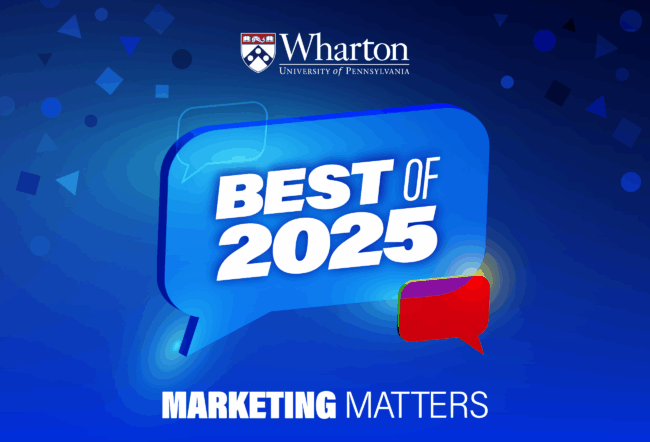Everywhere we turn, brands and organizations are under fire for failing to treat their customers with respect and dignity. In Marketplace Dignity, Wharton professor Cait Lamberton, Neela A. Saldanha, and Tom Wein introduce a tangible, practical way to take a stand on the fundamental value of humans, and in so doing, be a force for good in a society that increasingly demands that they do so. Marketplace dignity is the idea that customers seek respect and recognition from the firms they interact with, not just rational or emotional benefits. Marketplace dignity appeals to humans’ sense of justice and goes to the essence of what makes customers human. It is also a powerful driver of their engagement, loyalty, and satisfaction.
In this adapted excerpt from Marketplace Dignity, the authors reveal the three levers that you can use to design for dignity.
In March 2013, PepsiCo ran a three-part advertising campaign promoting Mountain Dew. The campaign featured an anthropomorphic, talking goat called Felicia.
We first meet Felicia in a restaurant, where she is filmed beating up a human waitress who has run out of the soda. Over the next two spots, Felicia is seen escaping police arrest and then in a suspect lineup—alongside five Black men—where she is identified as the assailant by her bruised and terrified female victim.
Felicia the Goat garnered a lot of attention for PepsiCo. The advertising community hailed the concept as novel, unique, and “sticky,” so to speak; some called it a “slice of crazed commercial perfection,” and even the “best ad ever.”
But even as PepsiCo was basking in praise from industry press, a significant backlash was gathering momentum on social media. By the time the scholar and political analyst Boyce Watkins published an article denouncing the Felicia the Goat ad as “arguably the most racist commercial in history,” the whole campaign had to be pulled.
Here was a campaign, wrote Watkins, that not only portrayed Black men as suspects but put them “on par with animals.” Mountain Dew had also managed to paint women as helpless victims, with no agency of their own, and the police as variously hapless incompetents or abusive thugs. The ads somehow managed to make goats look bad, too. By May 1, PepsiCo had pulled Felicia from all its channels and issued a statement: “We apologize for the offensive video and take full responsibility—made a big mistake—we’ve removed it from all our channels. #fail.”
While it’s hard to accurately quantify the hit to PepsiCo’s brand equity as a result of the Mountain Dew imbroglio, it’s clear that the company lost face very publicly in the aftermath. Felicia the Goat and Mountain Dew illustrate what can happen when brands go out on a limb to differentiate a product or service but fail to factor in the dignity of their customer base in the marketplace. And PepsiCo is by no means alone in making this kind of mistake.
The Marketplace Dignity Framework
Over the past seven years, we have conducted 25 large-scale studies across the United States, Africa, Latin America, and India, interviewing tens of thousands of people about their personal experiences with marketplace dignity.
In collectively listening to what scholars, business practitioners, and consumers have told us, we have identified three concrete and actionable pillars or levers you can use to evaluate and effectively design for dignity. These levers are:
- Representation: Feeling seen and heard
- Agency: Feeling in control
- Equality: Feeling treated as an equal
Let’s break these three levers down further to understand how each of them functions in the context of marketplace dignity and your customers’ experiences.
Representation
When people feel seen and heard by the companies they interact with, we call it representation. Representation also happens when people see and hear others who are like them within that company. And when this happens in a way that is both authentic and accurate, they know their individual and group identities are recognized and valued.
Representation can be simple to do and measure. It can be something as straightforward as using a customer’s name. Science tells us that hearing our own name has a powerful and instant neural impact: It relays the sense that someone is more interested in us, that we matter to them, and that they’re paying attention to us. It also aligns to our capacity for “self-representation,” which is something that comes naturally to us human beings.
While representation seems like it can be relatively simple to do, it can be extremely risky when things go wrong. Science tells us that consumers who are identified correctly feel more respected. But it also tells us that the opposite happens when consumers are misidentified. Mispronounce your customer’s name, and all your good intentions can be instantly corrupted—especially if you continue to use the wrong name without correcting yourself (and particularly after you have been corrected by the customer).
Agency
Agency is what happens when customers feel in control. When we feel that we have options and a meaningful chance to consent about our experiences with a brand, we feel empowered, enfranchised, and in control.
But firms should be careful about taking the customization = agency equation too far. When people have too many choices, it can become dizzying and overwhelming for them. The “paradox of choice” is well known and shows up in the marketplace: a UK survey showed that 83% of shoppers who abandoned a purchase did so because they were overwhelmed with too many options.
Choice matters, as does choice overload. But what about another “c”—consent? In the twenty-first century, user consent has become a burning issue for organizations, regulators, and customers alike. Yet many companies seem to drag their feet when asking for it.
Users are invited to consent to their data being collected, but in ways that essentially and all too often deny us our dignity. Terms and conditions are presented to us in ways that we cannot easily comprehend. One leading organization offers its users a terms and conditions document to read and sign that runs more than 18,000 words—about half the length of this book. It would take two hours and twenty-seven minutes to read it from start to finish.
Of course, many firms are purposefully and actively getting it right: showing ways forward that respect consent and dignity, and posting encouraging numbers in the process.
The Germany-based meal-kit company HelloFresh maintains that the best way to serve the bottom line is to put customers in charge of their own consent and subscriptions, and to give them the easy option of pausing their subscriptions, or even canceling them, whenever they want. The result? The company has experienced skyrocketing growth, posting 7.6 billion euros in revenue for FY2022, with “more than 1 billion meals shipped.”
Equality
Equality happens when people feel that companies and other individuals see them as peers. Equality also happens when the power differentials across various customer groups, and between customers and the firm itself, are minimized, when everyone receives the same even-handed and nondiscriminatory consideration and treatment.
As we have emphasized before, equality does not require that everyone be treated in precisely the same way. There are plenty of good reasons for offering benefits to loyal customers, tailoring bids for different customer segments, or offering premium and budget versions of your product. In fact, those are good ways of employing strategies of representation and agency. But explaining differential treatment in ways that are seen as fair can help consumers accept segment-based treatment.
A good example of this is the bronze, silver, and platinum model used by airlines. Customers are bracketed according to the number of air miles they fly, and as they notch up more miles, they progress toward different categories of benefits, perks, and treatment. Similarly, customers tend not to get annoyed by differential offers to the elderly or to early-bird subscribers. Different treatment, different prices—but still fair. Other companies like Happy Money credit lenders offer a form of personalization in prepayment rates that is contingent on customers’ individual needs and profiles, while still being fair to all—an approach that has led to interest from investors in funding their growth.
Remember that the equality lever simply requires that you do not proactively diminish the essential importance of each customer, and that you do what you can to minimize the power differential between you.
The Marketplace Dignity Framework: A Final Word
In our research, we have seen that the three levers of our Marketplace Dignity Framework recur in traditions of dignity around the world. Almost every society, philosophy, and religion has had some idea of dignity. And from Nairobi to Bangalore (Bengaluru), Chicago to Bogotá, these three levers to affirm dignity are the same.
In March 2020, we ran a study. We surveyed 400 Americans this time, and sure enough, when people feel they have been recognized, given agency, and treated as an equal, that’s when they tell us their dignity has been respected. We ran the study again. And again. And every time, these three factors matter. Later, we ran it in Nigeria and India too and found the same results.
The three levers of our Marketplace Dignity Framework are backed by research and undergirded by the evidence we have found in the field. They are also pragmatic. The three levers will provide practical and actionable suggestions on the paths your firm might follow to assure marketplace dignity for your customers at every touch point in their journey with you and your brand.
But our three levers are not to be followed blindly. At the end of the day, if you want to know what’s truly respectful—what you do or don’t do that affirms dignity—ask your customers. When you’re getting it wrong, if you take a moment to listen, people will soon tell you. And they’ll appreciate that you asked.
Excerpted from Marketplace Dignity: Transforming How We Engage with Customers Across Their Journey, by Cait Lamberton, Neela A. Saldanha, and Tom Wein, copyright 2024. Reprinted by permission of Wharton School Press.



